The 15-storey tower block of Belfast City Hospital dominates the south Belfast skyline.
The university teaching hospital has 900 beds and employs thousands of staff, many from ethnic minority backgrounds.
They treat those from the surrounding community as well as much further afield as several specialist services, including cancer treatment, are based there.
The hospital is situated on the Donegall Road, just a few hundred metres from the Sandy Row area, where last Saturday, a Syrian-owned supermarket and a cafe owned by a Sudanese businessman were destroyed and police attacked.
The attacks were carried out by people who earlier attended an anti-immigration protest a short distance away.
The district is Protestant and unionist, and loyalist paramilitary groups also continue to wield considerable influence.
In the area where the trouble occurred, the Ulster Defence Association holds sway.
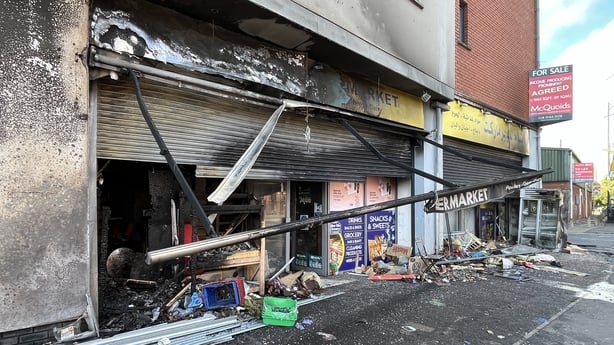
Every day of the week, doctors, nurses, porters, cleaners and other support staff, from what are termed ethnic minorities, drive and walk through the hospital gates to do their jobs.
During the past week, they've driven and walked past the charred remains of buildings targeted simply and only because their owners were people just like them, economic immigrants.
However, the health service in Northern Ireland, and many other areas of the public and private sector, simply could not function without these people.
The Belfast Health and Social Care Trust, the largest health trust in the UK, employs 7,931 nurses across five hospital sites, including the City Hospital.
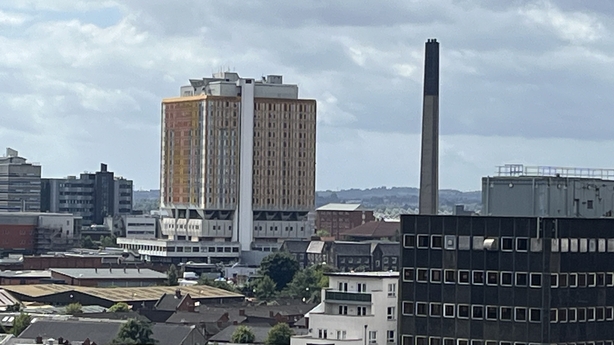
Of those, just over 1,000 are what are termed "international nurses", people who have come to Northern Ireland from a wide range of countries to find work, and to look after local people. That’s more than 12.5%.
Last Monday morning, I watched as one of them, a woman who looked to be in her late 20s, wearing blue hospital scrubs and a matching scarf covering her hair, walked past the Syrian-owned supermarket that had been destroyed.
She kept her head down, not making eye contact with me or a visiting US tourist taking photos of the damage.
It has to be stressed that the numbers involved in the violence were relatively small, the vast majority of people in the area were not involved and many have privately condemned it.
Members of that community also came to the rescue of a Romanian man who was seriously assaulted as he walked home along the Donegall Road last Sunday.
Police said several local people surrounded the man and protected him from further attack after he had been knocked to the ground and had his head stamped on.
There was further, less intense violence, in other loyalist areas of Belfast during the week, with businesses, homes and cars targeted, as well as police officers.
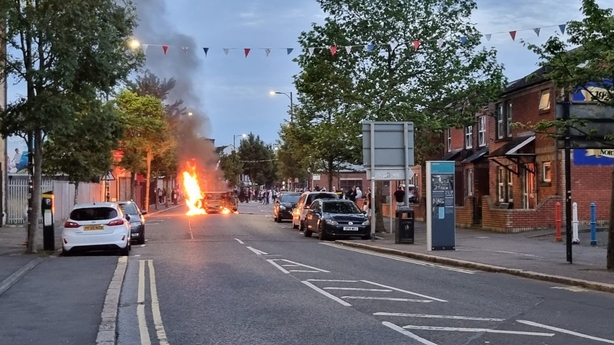
There have been many stories during the past week, illustrating the levels of fear now felt by many simply because of the colour of their skin.
Police, politicians, community workers and journalists have all been given similar accounts.
People afraid to walk or use public transport to go to work, parents afraid to let their children walk to the shop or play on the street.
Some are afraid to turn on lights in their homes at night for fear of attracting attention.
One incident being investigated by police involved a grown man walking up to a mother with a five-year-old child and screaming in the face of the young girl, telling her to "go f***ing home".
"At the moment there are members of ethnic minorities who are afraid to go out, they are afraid to go to work, they’re afraid to use public transport," Raied Al-Wazzan, vice chair of the Northern Ireland Council for Racial Equality told me as he attended a large anti-racism rally in Belfast city centre on Friday.
"They are afraid to go to the park or even to go out shopping."
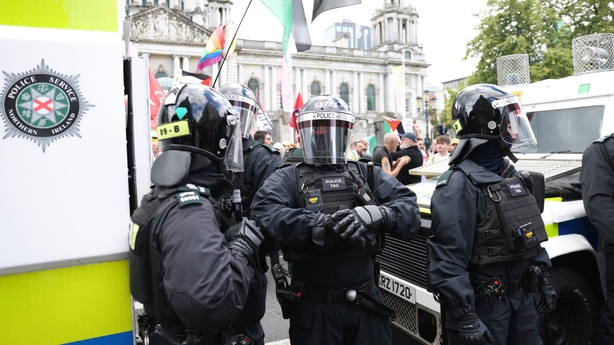
Police at times have struggled to cope with the violence due to its sporadic nature, and lack of clear intelligence about who was responsible.
To say it was the work of loyalist paramilitaries is much too simplistic.
Most of the rioters who attacked police and businesses in the Sandy Row last weekend were teenagers, some appeared to be even younger.
Some members of the UDA and the Ulster Volunteer Force have undoubtedly been involved, but police say they have not yet seen evidence that the organisations are orchestrating it.
The bottom line is, if the local paramilitary leadership had been in control of the rioting it would have been more intense and organised and the age profile of those taking part would have been older.
The numbers attending anti-immigration protests during the past week would also have been considerably higher if the loyalist groups had opted to mobilise.
However, nothing happens in loyalist working class districts of Belfast, and many other areas, without the knowledge or approval of the UDA or UVF.
"They may not be pulling the strings, but they are also not pressing the stop button," says a senior police source.
"There is no doubt they could escalate this situation if they wanted to, but there is also no doubt that they could de-escalate and put a halt to much of the violence."
At the moment, police believe the loyalist leaderships are in "passive" mode, watching how the protests play out and deciding whether they have anything to gain from intervening one way or the other.
The violence has exposed the impact of years of underfunding for the PSNI, something its Chief Constable Jon Boutcher has been keen to highlight.
The Patten Report, which reformed policing in Northern Ireland recommended that the PSNI should have a minimum number of 7,500 officers. In a recent report to the Policing Board, Mr Boutcher set 7,200 as the minimum threshold.
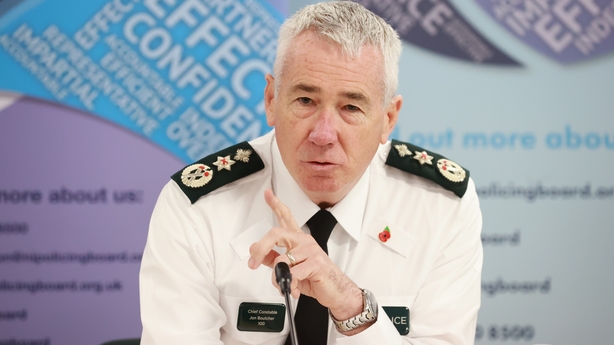
The PSNI currently has around 6,400 officers, well below those minimum thresholds. The problem is compounded by the fact that there are currently around 700 officers on sick leave, many of them on long waiting lists for ill health retirement.
In astonishingly frank remarks at a press conference last week Mr Boutcher said the police force he leads has been "allowed to decay."
"If you compare it with any other police organisation in England or Wales or Scotland or the guards [An Garda Síochána], we’re an outlier," he said.
Explaining the reason for asking for 120 reinforcements from Police Scotland, he added: "We cannot stand up and stand alone to deal with disorders like this anymore, we need support."
During the height of the Troubles, the RUC did not have to bring in support from other police officers to deal with much more intense and prolonged periods of rioting as it had around double the current number of PSNI officers and thousands of British soldiers were also on the streets.
It also had regular experience of dealing with large set-piece confrontations and had the numbers to apply different tactics.
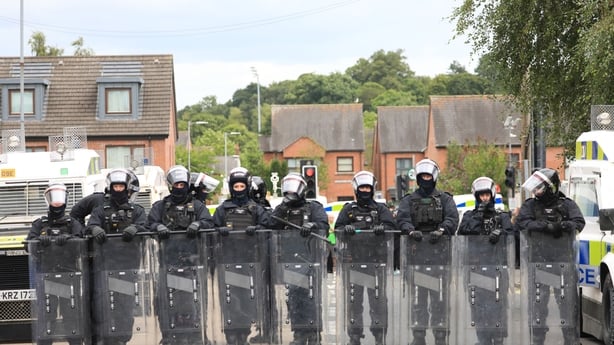
For many of the PSNI officers being pelted with petrol bombs and masonry last weekend, it would have been a new, and terrifying, experience.
One of the features of riots during the Troubles was the use of what were called "snatch squads", teams of police officers and soldiers who would come through their own lines, often supported by armoured Land Rovers or jeeps, and "snatch" perceived ringleaders from the crowd.
Police say they simply did not have the numbers or sufficient experience in the ranks to operate in that way last weekend and that officers attempting to do so could have been left dangerously exposed.
Mr Boutcher is engaged in a very public battle with the Stormont Executive and the British Treasury to secure funding to arrest the decay he has spoken of.
Policing is a devolved matter so funding is down to Justice Minister Naomi Long and what she can secure from her Executive colleagues. But the Executive and the Chief Constable are also hoping to secure additional special funding from Westminster.
They hope they have a trump card - British Prime Minister Keir Starmer is a former human rights advisor to the Northern Ireland Policing Board and is said to have retained a keen interest in all things PSNI.
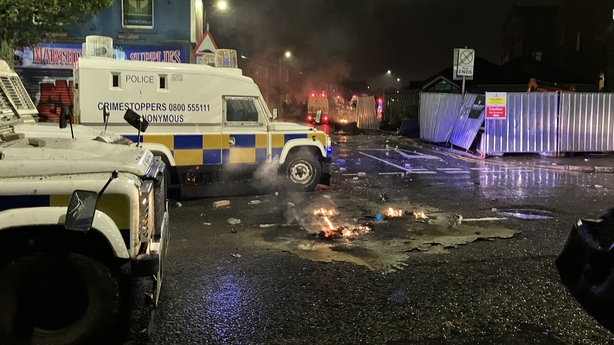
Speaking at another anti-racism rally in Belfast city centre yesterday afternoon, Raied Al-Wazzan praised police officers who put themselves in harm’s way to protect people and property.
He also urged Stormont’s politicians to "go to London and talk to the government there to get more funds for the police and give them enough support to protect us."
But that is in the medium to long term. For now, the immediate focus is on trying to end the violence and part of that task is identifying who is responsible.
If it is not loyalist paramilitaries at organisational level, then who?
A number of factors appear to be at work, including a myriad of anonymous social media agitators who frequently post misinformation and inflammatory claims.
An example was a protest outside a hotel in Belfast city centre last Monday night. A small number of anti-immigration protestors and counter protestors gathered outside after claims on social media platforms that refugees and immigrants were living in the hotel on a permanent basis and were frequently abusing the staff.
The reality is very different. It is a hotel I use regularly, and it was the base of the UK Covid Inquiry hearings in Northern Ireland. It has never been used as an accommodation centre for refugees.
Anonymous keyboard warriors are whipping up hysteria with false claims about the impact of immigration on housing, jobs, the health service and many other walks of life.
"They’re taking our jobs" is a refrain often heard from some of the protestors.
The reality is that those seeking asylum because they are fleeing from war zones or other threats to life are not allowed to seek employment no matter how long the application process takes.
Those business owners targeted last week did not take jobs from anyone, they built their own businesses and created employment.
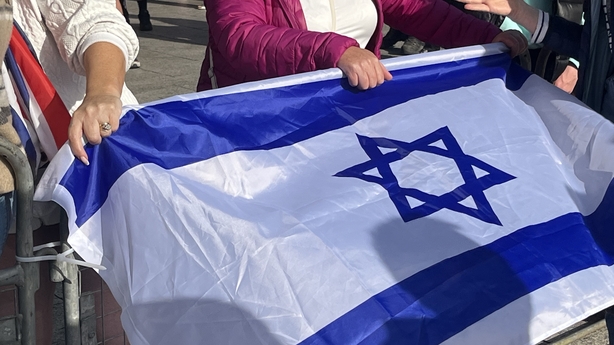
There is also an element of what is called "recreational rioting", bored young people excited by the thrill and risk of attacking police and setting fire to things.
And there is undoubtedly an element of the age-old "them and us" sectarian political culture of Northern Ireland at play.
Driving through many loyalist areas of Belfast and you will see Israeli flags alongside Union flags; driving through many nationalist and republican areas and you will see Palestinian flags.
The flags are also displayed by rival factions at pro and anti-immigration rallies.
Some see the conflict in the Middle East through the prism of the Troubles in Northern Ireland, the age-old battle of Orange v Green, loyalist v republican.
Many loyalists and unionists view Hamas and other Palestinian groups such as the PLO as the equivalent of the Provisional IRA.
The danger is that some of the loyalists engaged in racially motivated violence may view all non-white foreigners and immigrants through that same prism, as enemies.
That's why there was such shock when Irish tricolours appeared alongside Union flags and Ulster flags when a small group of anti-immigrant protestors from Coolock joined a rally in Belfast last weekend.
Police, journalists and members of the public looked on in disbelief at such an unlikely alliance, as a flag traditionally burnt by loyalists on Twelfth of July bonfires was waved alongside protestors in red, white and blue.
There were even reports that the visitors from north Dublin and loyalists from south Belfast had pints together after their joint protest.
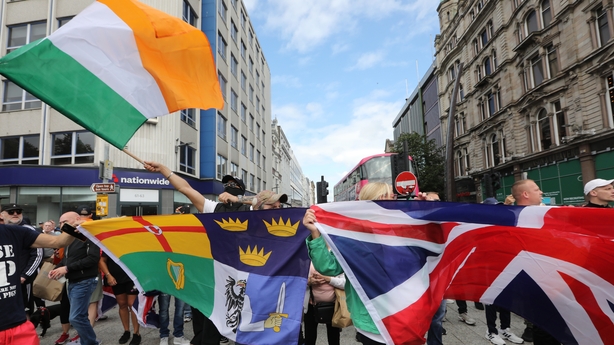
There was talk of a possible far right alliance, of a breaking of the traditional mould, of working-class loyalists and republicans finding common cause.
The reality is that the Coolock Says No protestors were most likely accepted into the loyalist fold on a temporary basis because those wrapped in Union flags viewed them as anti-immigrant, anti-Sinn Féin and therefore anti-IRA.
There is unlikely to be a repeat of this "hands across the barricades" moment.
Many loyalists have been highly critical of the images that appeared on television screens and newspaper pages, pointing out that the Tricolour is the flag of what they consider a hostile state.
The sight of some of the loyalist protests in Belfast’s Lower Ormeau Road last Saturday mimicking the firing of a handgun and a rifle and holding up five fingers to signify the murders of five Catholics in a bookies shop in February 1992 provoked a strong nationalist backlash against those in the Coolock contingent.
The Coolock protestors also encountered anger when they took their banner to an anti-immigration protest outside Garda headquarters last week, with some fellow protestors branding them "loyalists" and "traitors" and trying to seize the banner.
As own goals go, it was in a league of its own.
Read more: Several PSNI officers injured amid disorder in Co Derry
There were no Tricolours on display at an anti-immigration protest outside Belfast City Hall on Friday, a protest that was dwarfed by a scale of at least 10 to one by an anti-racist protest.
There were a few Israeli flags, while on the other side of a line of armoured police Land Rovers separated the two rallies there were dozens of Palestinian flags.
"You’re all the same, a bunch of f***ing terrorists," shouted one of the loyalist protestors, with his face covered.
Of course, not all of those taking part in such protests share those views.
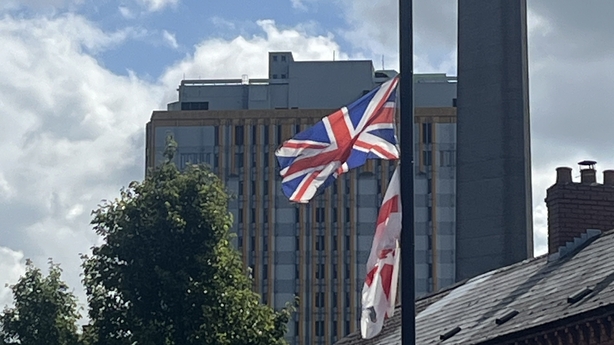
One man who described himself as a Protestant and loyalist from east Belfast told me he was there because he has genuine fears about the possibility of illegal immigrants becoming a potential threat.
"I work in a hospital," he told me.
"I know how important those immigrant nurses are and how hard they work; I see it every day. They aren't why I'm here, I'm here because I think this society could be under threat from those who don't come here legally and aren't interested in working or mixing with local people."
When I asked for his name and an interview he refused both.
"There's no way I'm doing an interview because the minute I do I'll be branded a racist and a fascist and I am not," he said. "Just because I'm worried about immigration doesn’t mean I'm evil."
That is part of the problem in this debate, north and south of the border.
Those who believe they have legitimate concerns and are not interested in violent confrontation shy away from voicing those concerns for fear of being tarred with the same brush as those who relish division and confrontation.
That means only the voices that shout loudest are being heard.
The PSNI mounted a huge and successful security operation this weekend to ensure there was no recurrence of the violence that followed similar protests last Saturday.
The fact that the 120 reinforcements from Police Scotland are not due to arrive in Northern Ireland until Tuesday indicates that police are concerned the violence in Belfast could continue.
If it does, anyone injured will be taken to the emergency departments at Belfast’s Royal Victoria or Mater hospitals where there is a strong possibility they will be treated by some of those international doctors, nurses and support staff.
Some of those carers will then go home in fear, perhaps opting not to turn on their lights.







